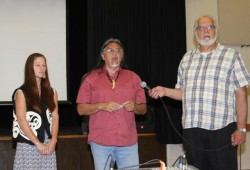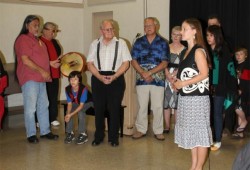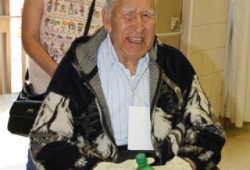It may have been movie-goer Jason Titian who said it best: The film Histakshitl Ts’awaatskwii, (We Come From One Root), which had its Port Alberni premiere on May 14, was both moving and enlightening, he said.
The film, which was screened at Echo Centre in Port Alberni, features Chuuchkamalthnii Ron Hamilton as he works on a family ceremonial curtain, or thliitsapilthim, which tells the story of a noble Hiikuulthat-h woman named Asmanahey who today has more than 400 descendants, including Chuuchkamalthnii.
But the film is far more than a story about this family history alone. It is the story about what the ceremonial curtain means to families in Nuu-chah-nulth territories, connecting people of the past to people of the future through the images that appear on the canvas screens.
The film discusses the people of long ago as Chuuchkamalthnii stands before the petroglyphs at Sproat Lake. He talks about the restrictions of the potlatch in more recent years, when traditional ceremonies were driven underground. Many made their crests from cloth, which could be quickly taken down and put away if an Indian Agent was approaching the village during a feast, Chuuchkamalthnii said.
We watch as Chuuchkamalthnii reproduces a curtain that was “informed by his Aunt Elizabeth Gallic (Puunii-i)”, and lost from the family through theft.
Chuuchkamalthnii is head of the Earthquake House, part of the Hupacasath. He’s painted about 50 curtains during his life, we learn from the film.
Pam Watts, Deb Cook, Shaunee Casavant, Ron Martin, Tyee Ha’wilth Maquinna Lewis George, Tyee Ha’wilth Christina Cox and Tyee Ha’wilth Derek Peters are among those who share their thoughts and feelings about curtains.
“That’s my family, that curtain” said Watts.
“It’s a story; it’s a history that belongs to our people,” said Maquinna, who said his curtain is meant to be inclusive of all Ahousaht houses. The curtain speaks about ha-houlthee, power, what he as head chief holds in his house for his people. He has added 20 feet on each end of the curtain that he received from his father, and Chuuchkamalthnii worked with the family for two weeks straight on the new images that tell the story of the Ahousahts. Maquinna’s son will add to the curtain when it is his time.
For Casavant, the curtain is the flipside of when people don’t treat our people so nicely, she said. It’s about self-esteem, identity and potlatching.
The curtain is also a place of transition, where dancers prepare behind it in one world, and when they move to the front they are in another world. What goes on behind the curtain at a feast is just as important as what goes on in front of it, the film tells us.
Huu-ay-aht Tyee Derek Peters said it takes a lifetime to understand the images, stories and songs that go with a curtain. He gives a brief history of how his curtain came into the family through the Ucluelet Nation.
Histakshitl Ts’awaatskwii premiered in 2010 at the University of British Columbia Belkin Art Gallery exhibition called Backstory: Nuu-chah-nulth Ceremonial Curtains and the work of Ki-ke-in (Chuuchkamalthnii). He worked with film-maker Denise Nichol Green, who has studied textiles in university and who was then studying anthropology at UBC.
Green was in attendance for the Port Alberni premiere and was presented a vest to acknowledge her award-winning work. Histakshitl Ts’awaatskwii received the Jean Rouch Award from the American Anthropological Association in 2010, and the Best Documentary nod from the Cowichan International Aboriginal Film Festival in 2011.
After the screening of the 67-minute film, Chuuchkamalthnii and Green took questions from the audience. Chuuchkamalthnii also displayed the finished version of the curtain featured in the film.
Chuck August said he wondered if his family, regular people, not chiefs but warriors, could have a curtain. Chuuchkamalthnii suggested that if he could get the name of the house he belonged to and the name of the head of that house, then he may already be connected to a curtain.
The film-makers hope to have another screening of the film in the new Alberni high school that is currently under construction. Contact Denny Durocher with the Huu-ay-aht nation for information about upcoming screenings.











